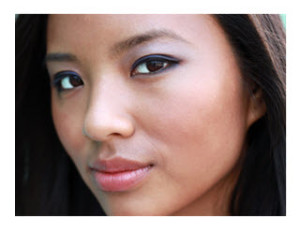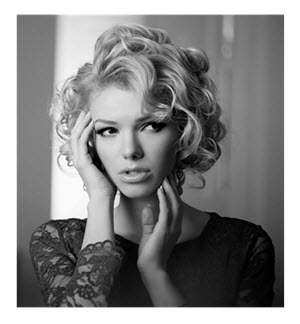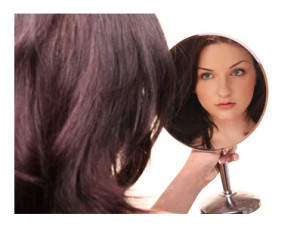Beauty. We all want it. We all chase it. Some of us hope to embody it in a variety of ways – and not just the beautiful face or figure.
 We are drawn to beauty in each other, however we define it, even as media and the Internet seem to be shifting what that means – or trying.
We are drawn to beauty in each other, however we define it, even as media and the Internet seem to be shifting what that means – or trying.
A recent feature in The Atlantic attempts to capture certain cultural nuances in what passes for beauty. In “What Beauty Looks Like From Argentina to Vietnam,” a young woman’s image is digitally altered to demonstrate the ways that our perceptions of attractiveness may vary.
While this cultural lens is moderately illuminating, the starting point is somewhat limiting as is the premise. This is one (lovely) American journalist’s face, an image of which she sent to designers around the world with an instruction to “make her beautiful.”
Has the Internet Reshaped Concepts of Beauty?
With no pretense of being a study per se, the results should be taken with a grain of salt. They don’t reflect variations we would expect, from the set of the eyes or the shape of a nose to the coloring of the skin, much less any indication of body type. That said, journalist Esther Honig possesses features that serve as a wonderful canvas, her skin was lightened by many of the country-specific designers, and the exercise provides an intriguing window into cultural perceptions to do with cosmetics, style, and media messaging.
What will you notice if you look at the images themselves?
Personally, I’m surprised there isn’t greater variation, which leads me to wonder if global standards of beauty have grown more homogeneous with Internet use than I could have imagined. Images that strike me most – naturally, these are personal impressions – are as follows: Argentina (more makeup than I expected), Germany (eyes are darkened, skin is eerily white), Philippines (garish hair and makeup), Morocco (dark liner and painted mouth, hair covered by scarves), the UK (illustrating a frightening plasticity), and one of two presentations for the US (with altered eyes, heightened hair, more pout than smile, and excessive cosmetics).
Preferred Body Type by Country
Curious after reading this piece, I searched for preferred body types by country. After all, a “beautiful” face is only part of the equation when considering our elusive ideals – as men or women.
 A clear picture was challenging to find. I have my doubts as to good “science” in this data, but one Divine Caroline article on ideal female body types tells us that Spain goes for pear shape and hourglass, Tonga likes plus-size, Italy doesn’t want emaciated, but… and no surprise here… Hollywood certainly does.
A clear picture was challenging to find. I have my doubts as to good “science” in this data, but one Divine Caroline article on ideal female body types tells us that Spain goes for pear shape and hourglass, Tonga likes plus-size, Italy doesn’t want emaciated, but… and no surprise here… Hollywood certainly does.
Today.com offers a recent representation of the “ideal” male and female body as compared to the average. In this country, we seem to be setting our (mental) sites on thinner models of both sexes, and according to some experts, that tendency is established by age 5.
The Ideal Male Body, the Ideal Female Body
While both men and women imagine ideals for body shape that differ from reality, those differences are more marked when it comes to expectations of the ideal woman. As you might anticipate, the preferred female body has larger breasts and is otherwise skinnier than the actual “average.” This is attributed (in the article) to media influences, in part.
Also interesting in the Today.com reference is this mention from UCLA researchers:
… asked to select among a number of possibilities, men entering a university dining hall — presumably hungry — preferred slightly heavier women than did men leaving — and presumably no longer hungry. Similarly, men with more money in their wallets… preferred thinner women than did men who had no money in their pockets.
The Sex Kitten Look
One of the strangely disturbing aspects of the US view of beauty as depicted in Ms. Honig’s experiment, certainly to me, is the reshaping of the eyes to appear more feline, recalling the early sixties sex kitten from Ann-Margret to Marilyn Monroe. The sex kitten displays both womanly curves and an overall demeanor that is vulnerable and childlike.
This same look also conjures the stretched and pulled skin of the overzealous facelift – something we’re increasingly accustomed to seeing.
As I searched the image database I use routinely, among the Monroe facsimiles is this woman. But note that while she dons the platinum hair, pouts with a sensual mouth, and strikes a demure but slightly provocative pose, she appears to be far thinner than Marilyn Monroe, whose voluptuous figure would be viewed as a plus-size in today’s fashion market.
Images Stored in the Mind’s Eye
The last time I visited my local bookseller, I lingered in the magazine aisle, paging through French Vogue. I was particularly taken by several moody, elegant ads of models with darkened eyes, soft pink lips, and wearing classic styles that were reminiscent of the late 1960s.
 These were the same waif-like, reed-thin, and pretty “mannequins” that I idolized as a preteen. To my surprise, I felt a momentary surge of yearning that echoed my earliest experience with similar images. And my immediate thoughts were very nearly the same: If only I could lose a few pounds… If only I could grow my hair longer…
These were the same waif-like, reed-thin, and pretty “mannequins” that I idolized as a preteen. To my surprise, I felt a momentary surge of yearning that echoed my earliest experience with similar images. And my immediate thoughts were very nearly the same: If only I could lose a few pounds… If only I could grow my hair longer…
Aspiration mingled with a spark of long-conditioned hopefulness: Beauty is within grasp, “if only…”
Beauty, From the Inside Out
Like many (American) women, I imagine I’m harder on myself than anyone else. When it comes to appearance, I have acquired greater acceptance with the years, though the seeds of “discontent” are deeply planted.
Where once I fretted over the shape of my nose or the thickness of my thighs, I’ve traded those concerns for the softening at my neck and the disappearance of once satiny skin. This isn’t something I dwell on – like most of us, I’m far too busy – and fortunately, impressions of loss are offset by appreciation for good health, a stronger sense of who I am and what I value, and my value – as a person and a woman.
Still, though I may treasure inner beauty in those I know and try to cultivate it in myself, I remain fully aware that a significant portion of our social and sexual currency, particularly as women, is heavily reliant on presentation, perception, and cultural interpretation.
Visit Esther Honig’s Before & After project for more detail.
You May Also Enjoy
I recently saw home movies of myself at 21. I was so beautiful and didn’t get it at the time. I hope we are teaching young women to love themselves and how they look–but all media messages do is tell them they are inadequate. Sadly.
I read a few months ago WHY FRENCH WOMEN DONOT GET FACELIFTS. I really enjoyed this book as I did her other on WHY they do not get FAT either. There are some good pointers there for us AMERICANS.I also am cooking from her books… really easy and delicious. I have gained 40 pounds in the last 28 years and its not coming off…. so I have accepted that. I adore my grey hairs…..unusual I know! The face is starting to change and thats a bit harder to swallow. But I am okay with it………..for now.
Our concerns with beauty just shift, don’t they? But they do, sadly, whisper “if only,” and “not enough as I am.” In some ways, on some days, I feel invisible to the male eye. Some days that’s okay. Other days it makes me angry. At them. Not myself. And other days I think, “Oh who the hell cares?” Living and breathing and being healthy at 50-something is more than enough.
Since I got married, I gained about 40 pounds in the last 5 years. I should blame this on my happy marriage LOL but I would definitely be happier if I can go back to where I was back then. Trying to accept myself just for who I am now though.